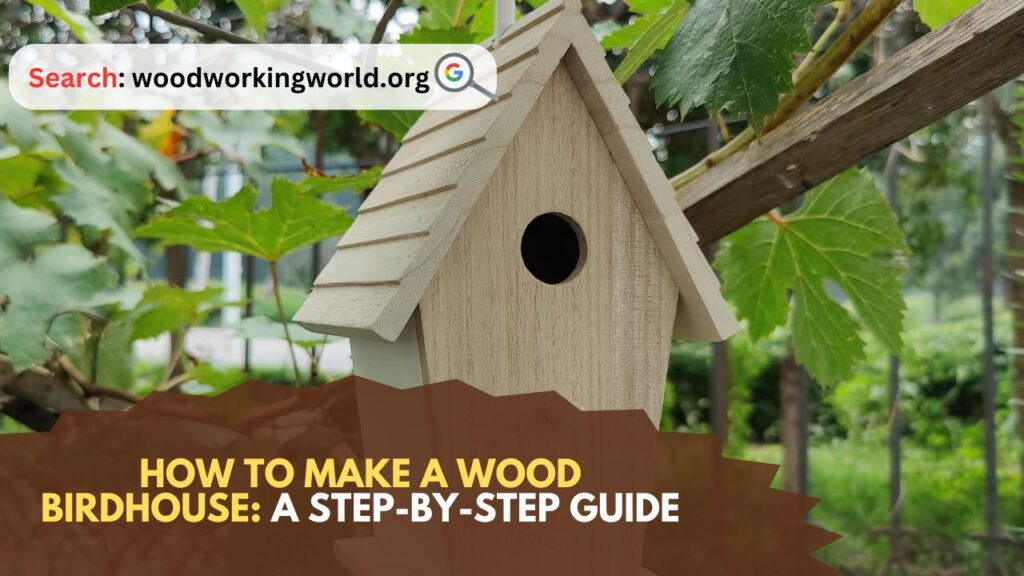Wood Birdhouse: Building a birdhouse is a delightful woodworking project that benefits local wildlife and enhances your garden’s charm. Whether you’re a seasoned woodworker or a beginner, creating a birdhouse can be a rewarding experience. This guide will walk you through the process of making a basic wood birdhouse that will attract a variety of birds to your yard.

How to Make a Wood Birdhouse
Materials and Tools Needed
Before starting, gather the necessary materials and tools:
Materials:
- 1 plank of untreated wood (cedar, pine, or redwood is ideal) measuring 1x6x6 inches
- Exterior wood screws (1 1/4 inches)
- Exterior wood glue
- Sandpaper (120 grit)
- Non-toxic exterior paint or sealant (optional)
- Hinges and latch (for a removable roof, optional)
Tools:
- Tape measure
- Pencil
- Speed square or carpenter’s square
- Saw (hand saw, circular saw, or jigsaw)
- Drill with various bits
- Screwdriver
- Clamps (optional)
- Paintbrush (if painting or sealing)
Step 1: Cutting the Wood
The first step is to cut your wood plank into the necessary pieces. You’ll need the following parts:
- Front: 8 inches tall x 6 inches wide
- Back: 10 inches tall x 6 inches wide
- Sides: Two pieces, each 8 inches tall x 5 1/2 inches wide
- Bottom: 6 inches long x 5 1/2 inches wide
- Roof: Two pieces, each 8 inches long x 7 inches wide
Use your tape measure and pencil to mark the dimensions on the wood plank. Then, carefully cut the pieces using your saw. Sand the edges to remove any splinters and ensure a smooth finish.
Step 2: Creating the Entrance Hole
On the front piece, mark a spot 6 inches from the bottom and centered horizontally. This will be the entrance hole for the birds. Use a drill with a hole saw bit to create a 1 1/2-inch diameter hole. This size is ideal for many common bird species, such as chickadees, nuthatches, and wrens.
After drilling the hole, sand the edges to smooth them out, ensuring the birds can enter without injury.
Step 3: Assembling the Sides and Bottom
Now, it’s time to assemble the birdhouse. Begin with the sides and bottom. Apply a bead of wood glue along the bottom edges of the side pieces. Attach the bottom piece to the sides, ensuring it is flush with the edges. Clamp the pieces together if necessary and allow the glue to dry.
Once the glue has set, reinforce the joints by drilling pilot holes and inserting screws. This will ensure the birdhouse is sturdy and can withstand outdoor conditions.
Step 4: Attaching the Front and Back
Next, attach the front and back pieces. Apply wood glue along the edges of the sides and bottom where the front piece will be attached. Position the front piece and clamp it in place. Once the glue has dried, drill pilot holes and secure it with screws.
Repeat this process for the back piece. Make sure the top edges of the sides, front, and back are aligned.
Step 5: Adding the Roof
The roof consists of two pieces that will overlap to protect the birdhouse from the elements. Position one roof piece so that it extends over the front and side edges by about an inch. Apply wood glue along the top edges of the front, back, and sides, and place the roof piece on top. Clamp it in place and allow the glue to dry.
Once the first roof piece is secure, apply glue along the top edge where the second roof piece will overlap. Position the second piece so it overlaps the first piece by about an inch, providing extra weather protection. Clamp it in place and let the glue dry. Drill pilot holes and secure both roof pieces with screws.
If you want a removable roof for easy cleaning, attach hinges to the back edge of the roof pieces and the back of the birdhouse. Add a small latch to the front to keep the roof securely closed.
Step 6: Finishing Touches
After assembling the birdhouse, inspect it for any rough edges or splinters. Sand any rough areas to ensure a smooth and safe surface for the birds.
You can leave the birdhouse natural or apply a non-toxic exterior paint or sealant to protect it from the elements. If you choose to paint or seal the birdhouse, ensure it is fully dry and aired out before placing it outside.
Step 7: Mounting the Birdhouse
Now that your birdhouse is complete, it’s time to find the perfect spot for it in your yard. Consider the following tips for optimal placement:
- Height: Mount the birdhouse 5-10 feet above the ground to keep it safe from predators.
- Location: Choose a quiet, sheltered spot away from heavy foot traffic and direct sunlight.
- Mounting Method: Use a sturdy pole, fence, or tree to mount the birdhouse. Avoid nailing it directly to a tree to prevent damage to the tree and ensure the birdhouse remains stable.
Attach the birdhouse securely using screws or mounting brackets. Make sure it is level and stable.
Step 8: Maintenance and Monitoring
To ensure your birdhouse remains a safe and inviting home for birds, regular maintenance is essential. Here are some tips:
- Cleaning: Clean the birdhouse at least once a year, preferably in late fall after the nesting season. Remove old nesting material and debris to prevent parasites and diseases.
- Inspection: Check the birdhouse periodically for damage and make any necessary repairs.
- Predator Protection: Consider adding predator guards, such as baffles or metal plates, to deter raccoons, cats, and other predators.
Conclusion: How to Make a Wood Birdhouse
Building a wood birdhouse is a fulfilling project that brings nature closer to your home. By following this step-by-step guide, you can create a cozy and safe haven for birds in your garden. Not only will you enjoy watching your feathered friends thrive, but you’ll also contribute to local wildlife conservation efforts. Happy woodworking!
I hope this article on How to Make a Wood Birdhouse has been helpful. If you have any further questions, please feel free to leave a comment below.
Video
